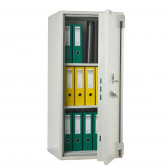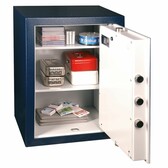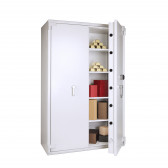Safes can be fitted with different types of locks. The simplest is of course the key lock. However, armoured cabinets can also have mechanical locks with a dial and electronic locks. Opening a dial safe can be a problem for someone who has never done so. From this article you will learn how to open a safe with a dial, with a numeric keypad and with a fingerprint reader.
How do you open a safe with a dial?
Safes equipped with a rotary dial are characterised by a high degree of security. Breaking the cipher is virtually impossible. Opening by listening to the locking mechanism with a stethoscope is merely a cinematic invention.
Opening a safe with a dial requires precision, as the dial has a hundred graduations. A slight mistake and the door will not open. This mechanism is not recommended for people who are impatient and have problems with hand trembling. If you are going to open the safe several times a day, constantly punching in the code can be a nuisance.
Opening the safe with the dial is simple, but it is worth practising the whole procedure for yourself a few times. After a few attempts, you will certainly become proficient. The manufacturer's standard cipher is usually 10-20-30-40. There are two graduations on the stationary dial. The one on the left is for changing the cipher and the one at 12 o'clock is for opening.
To open the lock, you need to do the following:
● Turn the dial clockwise and align the number 10 with the graduation used for opening, then make four full turns clockwise and align the number 10 with the graduation again,
● Turn the dial counterclockwise and align the numeral 20 with the graduation. Now make three full turns to the left and again align the number 20 with the graduation to open,
● Turn clockwise again and align the 30 with the main graduation. Now make only two full rotations to the right,
● Turn the dial to the left and align digit 40 with the main mark. Now only one turn counterclockwise is required,
● The last move is to turn the dial right as far as it will go and open the door.
How to open an electronic safe?
Now that you know how to open a safe with a dial, it is still worth finding out how to open electronic safes. These models are much simpler to open. Locks with a numeric keypad only require you to enter a code and then confirm with an Enter, key or cross.
Electronic safes with keypads are convenient because the code is entered easily and quickly. Frequent opening of the safe is not cumbersome. Unfortunately, the cipher can be accidentally learned by an unauthorised person. It is enough for someone to view the opening procedure. Remember to change the code periodically. The more people have access to the safe, the more often you should change the cipher.
We describe this topic more extensively in the articles:
Changing the code on your safe. 5 facts you need to know
How to change the code in a safe? Overview of the most common locks
One of the more secure solutions is to purchase a safe with a biometric lock. This type of security is the most convenient because you do not have to remember the code. Only people whose fingerprint has been entered into the system can access the safe. You don't have to worry that an unauthorised person will suspect the entry of the cipher.
Unfortunately, the biometric lock also has its drawbacks. It is enough to cut your finger and you no longer have access. If you are prone to minor injuries at work, it is better to choose a different lock. Remember also that both the reader and the fingerprint must be clean. Minor soiling will make it impossible to open the safe.
How do you open a safe with a dial when you don't know the cipher?
It can happen that you forget the combination to the lock, or you inherit a safe for which you don't know the code. How do you open a safe with a knob if you don't know the password? The only solution is to call a locksmith or contact the manufacturer.
Trying to forcibly open a safe will not only damage the device, but could also affect your health. All it takes is for a crowbar or other tool to slip through and a disaster is at hand. Don't use inexperienced locksmiths either, as you will only lose time and money. If you want to open a locked safe without any problems, contact the experts at Hartmann Tresore.
This may be interesting you: Which combination lock safe to choose?
Emergency opening of an electronic safe
Electronic safes may also require emergency opening. However, it is first worth ruling out the most trivial reasons for not being able to get in. Numeric keypad locks run on batteries, so check to see if they need replacing.
Electronic locks are equipped with revision, i.e. an ability to open with a key. Biometric security locks require a permanent connection to the mains electricity supply. In the event of an emergency and power failure, it is useful to know where the revision and the key are located.
Some locks require the front panel to be pulled off in order to reach the revision. This is not a complicated operation but requires basic tools such as keys and a screwdriver.
Now that you know how to open a safe with a knob and one equipped with an electronic mechanism, there is nothing left to do but order the right model. Remember, however, that the armoured safe must have a security certificate as specified in the standards EN 14450 and EN 1143.





